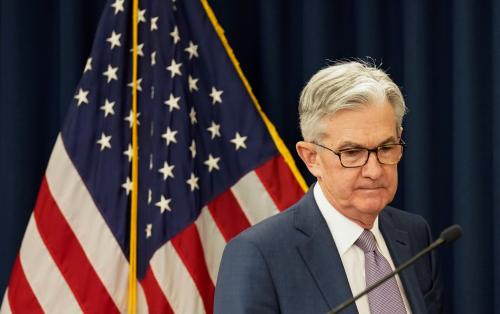The Federal Reserve has taken a number of recent actions to support the flow of credit to households and businesses during the COVID-19 crisis.[1] In addition to providing liquidity as the lender-of-last-resort, they are encouraging banks to draw on their capital and liquidity buffers to support credit flows if lending and other actions are taken in a safe and sound manner.[2] In its statement, the Fed emphasized that U.S. bank holding companies currently hold capital and liquidity in excess of regulatory minimum requirements.
The Fed now needs to make clear to banks how they can use their buffers without risking questions later about whether a bank was operating in a safe and sound manner. That would be better than an alternative suggested by some that the Fed should go further and temporarily relax regulatory requirements. (For a Fed FAQ on its guidance to banks, click here.)
Macroprudential policy actions to encourage banks to use buffers to support the economy can work only if the financial sector starts from a position of financial strength. Fortunately, that’s where the system is now, thanks to the stricter regulatory regime put in place after the financial crisis, which requires more and better-quality capital, stress tests, and liquidity buffers, as well as better risk management practices on the part of financial institutions themselves. Tier 1 common equity ratios average over 12 percent for the largest banks, above the regulatory and stress test requirements. Liquidity coverage ratios are above 100 percent, determined by bank internal stress tests. That means banks have more than enough liquid assets—cash, reserves deposited at the Fed, U.S. Treasury securities, etc.—to meet demand for 30 days in a stressful situation.
On the use of liquidity buffers, there are no clear lines on what banks are permitted to do. Here, the Fed should provide guidance to banks and can be aggressive, given banks can access the discount window. The Basel III liquidity requirement did not define a minimum or a buffer. If the LCR buffer was entirely a buffer, then, in principle, it could be drawn down to zero without falling below a minimum requirement. But that is unrealistic—neither the bank nor regulator would think that a safe and sound practice. But it’s unclear to banks how much they can safely draw on their liquidity buffers. The Fed should provide clarity on that consistent with the intent of the liquidity buffer as a safeguard. Banks conduct their own liquidity stress tests, and they could modify their scenarios to include greater use of the discount window to define a buffer that is defensible. Another idea is to allow banks to add to the amount of their liquid assets some fraction of their assets that are eligible collateral for the discount window; that could make sense if liquidity risk managers are concerned that a buffer that fell below 100 percent—the 30-days-worth of liquidity—would be a sign of high risk to investors. At the very least, Fed should make clear that banks should not be increasing the severity of their internal tests now, which could mean that they would have to add to their liquid assets, and instead encourage the use of the discount window.
In contrast to the liquidity buffers, the capital buffers that can be deployed to support credit flows to households and businesses are well-defined. Capital held by management above regulatory requirements can be used, and the capital conservation buffer, expanded by any globally systemic important buffer (GSIB) surcharge, is designed to be drawn down—though substantial drawdowns would lead to incremental reductions in shareholder payouts and compensation. In the U.S., in contrast to some other countries, there is no countercyclical capital buffer to release. (The fact that the countercyclical capital buffer (CCyB) cannot be deployed does not mean that it should have been raised previously. The Fed’s decisions were based on their views of evolving systemic risks at that time, and raising the CCyB would have imposed costs then.) Leverage ratios are now less constraining since the Fed issued the Stress Capital Buffer, which exempts the leverage ratio from the annual stress tests. Moreover, firms that reduce shareholder payouts will add to their buffers that can be used for lending, and the eight largest banks announced that they would suspend share repurchases through the second quarter. This increment to capital is not insignificant; share repurchases for these banks in 2019 totaled almost $100 billion.
Still, banks now are grappling with how much capital needs to be set aside for borrowers facing temporary disruptions. To be sure, what losses are temporary and what are more sustained is very hard to assess. But at a minimum, if banks are encouraged to help households and businesses directly hit by the COVID-19 virus by deferring principal and/or interest payments, they need clarity about how much those actions could reduce their capital positions. Such guidance does not require a change in regulation, but is a balance between modifying too many loans or modifying too few. Encouraging the use of capital buffers will help the financial system and the economy only if it does not raise the prospects of insolvency risks, but higher initial buffer allow much more flexibility.
Relaxing buffers or even changing rules temporarily will not resolve the current public health crisis nor compensate for the losses in asset prices. Indeed, the large draws by corporations on their committed lines and letters of credit will strain bank balance sheets. Some of that was anticipated in the supervisory stress tests. For many years, those tests have assumed a global recession with severe stresses in the corporate sector. But corporate draws on credit lines are producing additional exposure to business customers on bank balance sheets, so they are not likely to want to absorb more corporate bonds in their inventories. If authorities think there is a need to stem the fall in bond prices and possible fire sales, responses by fiscal authorities or traditional buyers of corporate bonds would be a better way to reduce systemic risks.
Changing regulations in the midst of financial turmoil often has unintended consequences, and is not good practice, though may be the only option in extremis. A better alternative is to deploy regulatory buffers that were built up in anticipation of sharp downturns, even as unlikely as they might have seemed, but more clarity about how to use buffers will make this action more effective. Of course, there will be many learnings from the current stressful episode that can be the basis for improving regulations in the future.
[1] https://www.federalreserve.gov/newsevents/pressreleases/monetary20200315b.htm. They also issued supervisory guidance in the previous week to work with their borrowers. https://www.federalreserve.gov/newsevents/pressreleases/bcreg20200309a.htm [2] Macroprudential policies are designed to increase resilience of the financial sector to negative shocks and to reduce amplification because of disruptions in credit (or financial services more broadly). This means that on the upswing, financial firms should build buffers in anticipation of future problems. Then in a downturn, buffers can be released, which relaxes constraints and allows firms to continue providing credit.
The Brookings Institution is committed to quality, independence, and impact.
We are supported by a diverse array of funders. In line with our values and policies, each Brookings publication represents the sole views of its author(s).







Commentary
The Fed should clarify how banks can deploy capital and liquidity
March 20, 2020